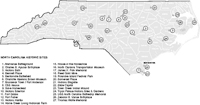State Historic Sites Program
The State Historic Sites Program began as a small operation in the North Carolina Department of Archives and History in Raleigh in October 1955. When the program was created, the General Assembly transferred to it, from the Department of Conservation and Development, responsibility for several historic sites; it soon administered a dozen sites across the state. In 1969 the State Historic Sites Program was joined by the state history museum and a fledgling historic preservation program to become the Division of Historic Sites and Museums. After five years it was split to form the North Carolina Museum of History and the Historic Sites Section, the latter agency combining traditional historic sites functions with federally funded statewide preservation and survey operations.
 In October 1975, when there were 19 field units, the program was divided into three sections: Historic Sites, Historic Preservation (soon also to include archaeology), and State Capitol/Visitor Services. A few years later the Historic Sites Section subdivided into five branches: Administration, Archaeology, Interpretations, Operations, and Property Development. By 1995 the program employed 135 full-time staff members and had an operating budget of more than $5 million.
In October 1975, when there were 19 field units, the program was divided into three sections: Historic Sites, Historic Preservation (soon also to include archaeology), and State Capitol/Visitor Services. A few years later the Historic Sites Section subdivided into five branches: Administration, Archaeology, Interpretations, Operations, and Property Development. By 1995 the program employed 135 full-time staff members and had an operating budget of more than $5 million.
By 2006 the program included 27 State Historic Sites (see map), a home office, and two regional field offices. The Raleigh staff provides overall management and technical support for the historic sites, which stretch from Manteo to Asheville. Regional management teams, composed of personnel elected periodically from field sites, represent their sites and regions in planning priorities across the state and working with the teams in the home office. Of the sites, the most heavily visited are Fort Fisher, the North Carolina Transportation Museum, and Reed Gold Mine. Collectively, the sites annually offer more than 75 special programs and events, ranging from Civil War reenactments to dramas and festivals.
List of State Historic Sites:
- Alamance Battleground
- Charles B. Aycock Birthplace
- Historic Bath
- Bennett Place
- Bentonville Battlefield
- Brunswick Town/Ft. Anderson
- Charlotte Hawkins Brown Museum
- CSS Neuse / Governor Caswell Memorial
- Duke Homestead
- Historic Edenton
- Fort Dobbs
- Fort Fisher
- Historic Halifax
- Horne Creek Living Historical Farm
- House in the Horseshoe
- North Carolina Transportation Museum
- USS North Carolina Battleship Memorial
- President James K. Polk
- Reed Gold Mine
- Roanoke Island Festival Park
- Somerset Place
- Historic Stagville
- State Capitol
- Town Creek Indian Mound
- Tryon Palace Historic Sites & Gardens
- Zebulon B. Vance Birthplace
- Thomas Wolfe Memorial
Reference:
Richard F. Knapp, ed., North Carolina's State Historic Sites: A Brief History and Status Report (1995).
Additional Resources:
State Historic Sites Program official website: http://www.nchistoricsites.org/
North Carolina Division of State Historic Sites. InSites: news from the North Carolina Division of State Historic Sites. 2004-2006. https://digital.ncdcr.gov/Documents/Detail/insites-news-from-the-north-carolina-division-of-state-historic-sites-2006-june-july-v.22-no.3/2956181
Image Credits:
History In Action. YouTube video, 1:17, Posted by ncculture, June 24, 2011. http://www.youtube.com/watch?v=Dp8DrngAoJc (accessed September 19, 2012).
1 January 2006 | Knapp, Richard F.